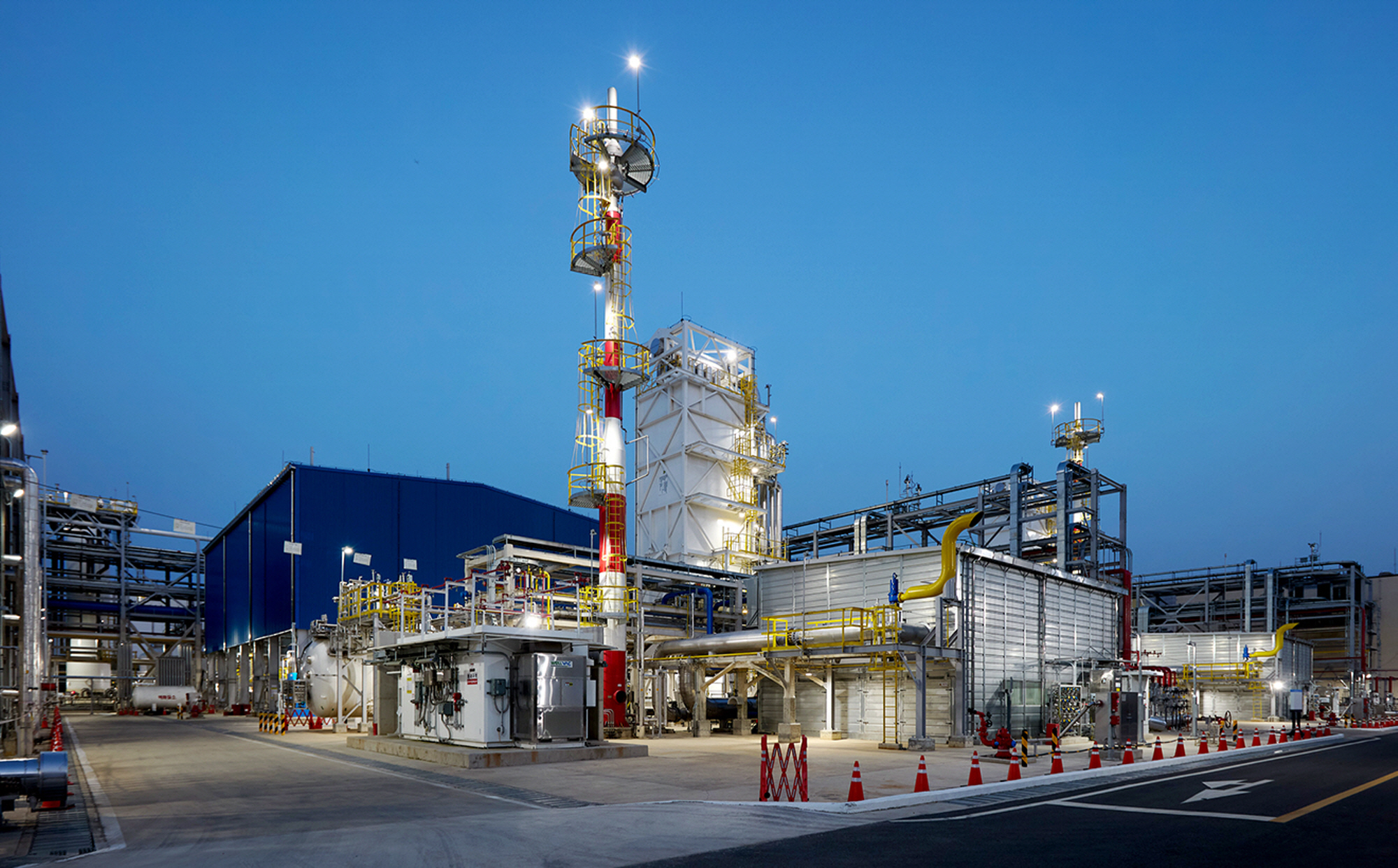SK E&S has announced the opening of the world’s largest liquid hydrogen plant in Incheon, with an annual production capacity of 30,000 tons, signaling the start of the ‘hydrogen mobility era.’ The successful establishment of large-scale liquid hydrogen supply capabilities in South Korea is expected to accelerate the adoption of hydrogen buses and more.
On the 8th, SK E&S held an inauguration ceremony for the Incheon liquid hydrogen plant in Wonchang-dong, Seo-gu, Incheon. Aigi, a subsidiary established by SK E&S to promote the liquid hydrogen business, oversees this operation.
Notable attendees at this ceremony included Minister of Trade, Industry, and Energy An Deok-geun, Chairman of the National Assembly’s Trade, Industry, and Energy Committee Lee Jae-jung, Mayor of Incheon Yu Jeong-bok, Chairman of KDB Industrial Bank Kang Seok-hoon, CEO of SK Inc. Jang Yong-ho, President of Export-Import Bank Yoon Hee-sung, President of IBK Industrial Bank Kim Seong-tae, President of the Korea Gas Safety Corporation Park Kyung-guk, and CEO of SK E&S Chu Hyung-wook.
The Incheon liquid hydrogen plant refines gas-phase byproduct hydrogen produced by the nearby SK Incheon Petrochemical facility into high-purity hydrogen, which is then cooled to produce liquid hydrogen. Equipped with three 30-ton liquefaction units and six 20-ton storage facilities, it is capable of producing approximately 30,000 tons of liquid hydrogen annually—the world’s largest for a single plant. This volume is enough to power around 5,000 hydrogen buses for one year.
Liquid hydrogen is created by cooling hydrogen, which exists in gaseous form at room temperature, to a cryogenic state of minus 253 degrees Celsius. It occupies 1/800 of the volume of gaseous hydrogen and is about ten times more transportable per shipment, making it advantageous for large-scale storage and transport. It can be transported safely at low pressure, allowing rapid refueling with short waiting times, and is considered a “game changer” for converting commercial vehicles such as buses and trucks to hydrogen. For this reason, in countries like the U.S. and Japan, the hydrogen industry has matured around the use of liquid hydrogen.
The Incheon liquid hydrogen plant marks the first visible success of SK E&S’s ongoing hydrogen ecosystem development plans. In March 2021, SK Group announced the plan to establish the Incheon liquid hydrogen plant at the 3rd Hydrogen Economy Committee meeting chaired by the Prime Minister. Since then, they have embarked on a project to foster a hydrogen ecosystem centered around SK E&S. At the time, SK Group Chairman Choi Tae-won stated, “By leading the establishment of South Korea’s hydrogen ecosystem, SK will fulfill its corporate responsibility towards achieving carbon neutrality by 2050.”
The promotion of this project has highlighted the importance of ‘public-private cooperation.’ Until now, there have been no case studies for using liquid hydrogen in South Korea, resulting in a lack of existing safety and technical standards under current law, with the creation of new legislation projected to take 2-3 years. Although project delays seemed unavoidable under these circumstances, the Ministry of Trade, Industry and Energy supported the project by implementing a ‘regulatory sandbox’ system that stimulates new industry creation through innovative technologies. Additionally, the Ministry of Environment has supported the establishment of key infrastructures for liquid hydrogen logistics through a “private capital subsidy project for hydrogen refueling station construction.”
Incheon City and Seo-gu also actively cooperated to lead negotiations with relevant agencies for the necessary licensing procedures to ensure the timely completion of the Incheon liquid hydrogen plant. The successful completion of the plant is expected to significantly bolster Incheon City’s policy for converting city, metropolitan, and charter buses to hydrogen, in line with its vision of becoming a ‘hydrogen leading city.’
With the inauguration of the Incheon liquid hydrogen plant facilitating large-scale production of liquid hydrogen, problems associated with unstable hydrogen supply, such as the recent “hydrogen refueling crisis,” are anticipated to be resolved. Additionally, it is expected to lay the groundwork for South Korea to become a “hydrogen economy leader.”
Besides large-scale liquid hydrogen production, SK E&S plans to advance its liquid hydrogen charging business, contributing to the establishment of a complete hydrogen mobility ecosystem. To this end, SK E&S is working to establish approximately 40 liquid hydrogen refueling stations nationwide, centered around its subsidiary, SK Plug Hyverse. The liquid hydrogen produced in Incheon will be reliably supplied to various demand locations through refueling stations to be set up in Busan, Cheongju, Icheon, and elsewhere. This year, the aim is to commence operations for about 20 liquid hydrogen refueling stations.
An official from SK E&S stated, “By converting public transport—the ‘feet of citizens’—to hydrogen vehicles, we will contribute to greenhouse gas reduction in the transportation sector and mark the beginning of a ‘tangible hydrogen public transport era’ in our daily lives.”
At the inauguration ceremony, three domestic liquid hydrogen producers, including the Korea Petroleum Management Institute (the dedicated agency for hydrogen distribution), Aigi, Hyosung Hydrogen, and High Changwon, also signed a memorandum of understanding to establish a ‘liquid hydrogen supply and demand cooperation system.’ They plan to cooperate in exchanging liquid hydrogen quantities and holding stocks to ensure a stable supply.
CEO Chu Hyung-wook said, “The inauguration of the ‘Incheon Liquid Hydrogen Plant’ is the first stepping stone to make the vision of the ‘hydrogen era’ that SK E&S has envisioned a reality. This year will be remembered as the inaugural year of the ‘liquid hydrogen era,’ which will change the course of the energy industry in South Korea. We will do our utmost to carry out the operation of the Incheon liquid hydrogen plant and the establishment of the liquid hydrogen refueling infrastructure without fail, contributing to the creation of a stable hydrogen supply ecosystem.”

